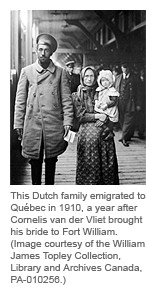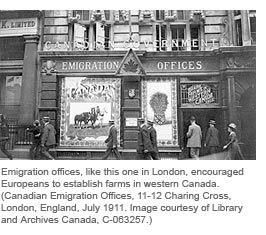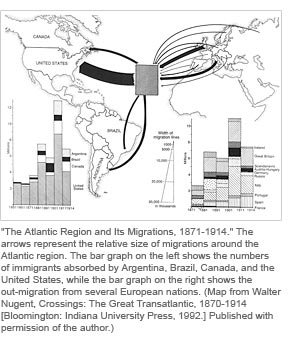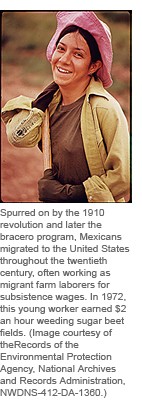Crossing National Borders: Locating the US in Migration History
Story of One Dutch Family Illuminates Immigration History
In 1909 Jantje Enserink van der Vliet entered the United States, headed for a rural Dutch American community. Depending on how you define it, she was or was not a part of U.S. immigration. Her story, and that of her spouse Cornelis van der Vliet, began in the Netherlands, where Jantje, the oldest and only daughter of a widower, was keeping house for her farmer father and eight younger brothers. Cornelis came to stay with the Enserinks for a few months to learn about farming techniques unfamiliar to him before he embarked on a journey for South Africa, where he hoped to become a farmer himself. In 1903 he made his way south to live with the Dutch-descended Afrikaners, and for the next three years he moved from one rural district to another, with little success at farming. He attributed part of his failure to a lack of a spouse. Cornelis decided to try elsewhere and went via England to Canada, where he got a job doing railroad construction. His interest in farming, however, was unabated, and this time he wanted to make sure he had a suitable spouse. He had not been on his railroad job long before he wrote back to Jantje Enserink, asking her to marry him.

In 1907 Cornelis returned to the Netherlands to marry Jantje and bring her back to Canada. There were many Dutch migrants going to North America in this period, and those interested in farming were slightly more likely to go to Canada than the United States due to land availability. When Jantje arrived at their new home outside Fort William, she found she was the only woman in a work camp, and that the house she expected to share with Cornelis would also house six relatives and friends, for whom she would do the cooking and cleaning. Not long thereafter Jantje's health began to go downhill, so Cornelis suggested she go to the United States, specifically to Minnesota, where his sister lived on a farm with her husband and child. Whatever Jantje's "illness," she had a miscarriage not long after she arrived in Minnesota, and while still there she learned that Cornelis had died of appendicitis while working on the railroad. Seeing no reason to go back to Canada, Jantje remained in the United States, continuing to live with Cornelis's sister and doing housework for wages as well. A little more than a year later, Jantje Enserink van der Vliet headed back to the Netherlands, where she got a job as a housekeeper (1). As the Van der Vliets' story shows, the study of people who cross national borders encourages historians to think beyond national histories and the terms that are caught up in them.
Individual lives linked to broader factors encouraging or discouraging migration across borders. Two factors that were prominent in this case were economics and familial ties. Economic circuits brought farmers in the Netherlands into competition with those elsewhere, dimming future prospects for someone like Cornelis van der Vliet, the son of a farmer. Land prices, cost of living, wages—these were pieces of information that made their way across borders to potential migrants in the nineteenth and twentieth centuries. Cornelis sought to take advantage of the economic activity associated with rebuilding after the Anglo-Boer War. Ethnic ties meant Van der Vliet could expect to be able to function in Afrikaans-speaking segments of South Africa. But he came as a carpetbagger of sorts, at a time when at least some Afrikaners were disgruntled with the lack of support the Netherlands had provided during the war and distrustful of those who came afterward. This situation, and his single status, made farming more difficult. When his attempts in South Africa failed, he turned to North America and to railroad work in order to amass an economic base. Railroads were part of the infrastructure linking various parts of the world; at the same time they offered opportunities for men (and less often women) to earn a living—if they survived. Cornelis recruited several relatives and friends to join him in Canadian railroad work when he went back to the Netherlands to marry.

Meanwhile Jantje Enserink became part of an international marriage market when Cornelis wrote from Canada asking her to wed. Perhaps there had been signs of romance before; perhaps she was tired of caring for her younger brothers. There were many women, especially in rural areas of the Netherlands, who wanted to marry, but had few opportunities due to the lack of young men with reasonable economic prospects. Marriage to an international migrant, or migration themselves with hopes of marriage, became an alternative. Familial motivations—joining spouses, parents, and other relatives, as well as trying to escape marriage and/or family duties—were major forces for migration. In other words, individual stories such as that of Cornelis and Jantje Enserink van der Vliet illustrate how economic systems and family ties crossed borders. Other migrants, notably refugees, add other categories of linkage, but the basic principle of migrants as challenges to national histories remains.
To label Jantje Enserink van der Vliet an immigrant to the United States would be technically accurate, but misleading. "Immigration" typically has implied a person moving across a national border to live in a new country, a one-way movement. Because there were many who returned to their homelands, particularly after transportation innovations made this easier and less expensive in the mid-nineteenth century, scholars have increasingly used migration as the term to cover those moving, sometimes back and forth many times and from one location to others, as Cornelis and Jantje Enserink van der Vliet did. A further caveat in terms of defining migration is that many migrants did not cross national boundaries but faced major cultural differences nonetheless. When Jantje went to live with her in-laws in Minnesota, she joined a Dutch-speaking farming community complete with a church. Would that have been a more difficult transition than one of her likely alternatives had she remained in the Netherlands—going to work in a major urban center there? Stories like this suggest the need for a continuum of adjustment.
For that reason, recent scholars often pay less attention to national boundaries than to cultural connections and disconnections. Immigration historian Dirk Hoerder used the title Cultures in Contact (2002) for his recent prize-winning history of migration, which spanned a millennium and the globe. Hoerder defined migration broadly, to include any move beyond the parental home, though his focus for the study went beyond the individual level to discuss 10 circuits, "webs" of connection of commerce and knowledge, which spurred people to move extensively—across the Atlantic or Pacific, for example. These webs meant people, money, goods, and ideas moving in different directions—blending, clashing, changing.
An Overview of U.S. Immigration
The United States was connected into these webs of migration, although its importance within each system varied across time. Prior to independence it connected into the Atlantic system through two major streams of migration: people taken as slaves primarily from western Africa and migrants from Europe, particularly the British Isles and German-speaking states (including many indentured servants). North America was a minor destination in the slave trade, dwarfed by the plantation economies of the Caribbean and parts of South America. In 1808, furthermore, the importation of slaves from Africa officially ended for the United States, one small part of an ongoing battle to outlaw the slave trade internationally. The other stream of migration to the United States, from Europe to the new nation, continued. By the 1840s the United States was also connecting into the Pacific migration system, with some men (and very few women) coming from southeastern China until racially motivated exclusion acts curtailed this movement.

The largest migration to the United States (and to North America more generally) throughout the nineteenth century and into the twentieth century came from Europe. German speakers and Irish along with smaller groups from other parts of northern and western Europe predominated early in the nineteenth century. They were part of a group of "moving Europeans," responding to various economic, religious, and political opportunities and changes (2). Most who moved still remained in Europe. Others sought opportunities elsewhere, like Cornelis van der Vliet, and yet others followed these individuals (albeit sometimes reluctantly like Jantje Enserink). In the circuits of connection from Europe, the United States attracted the largest number of transatlantic migrants, but not necessarily the largest for all groups or per capita: Argentina had a much higher proportion of migrants (58 percent foreign born and their children in 1914); Canada was comparable to the United States in terms of growth rates and started offering land on the prairies around the time that farms became harder to get in the U.S. (3). The national border along the 49th parallel made less difference to the Van der Vliet families moving to North America than did the issue of where they could find work and land.
By the late nineteenth century, migrants to the United States increasingly sought urban and industrial employment opportunities or connections to those who had them. In the United States this shift in predominance to industrial labor coincided with a shift in the proportion of migrants from southern and eastern Europe, whom policymakers called "new immigrants" even though many from western Europe in this period also fit this pattern. The shift to steam transportation and the expansion of railroad lines contributed to making migration easier and cheaper and hence led to a major expansion in the numbers of migrants, many of whom returned to their homelands and sometimes came back again. Factory and domestic service work might not support a family in the United States, but at least in some cases it could provide sustenance for an individual plus a chance to send remittances back to others in areas where dollars translated into a higher standard of living.
As a consequence of the Spanish American War, the United States became more enmeshed in the Pacific migration system, particularly through the acquisition of Hawaii and control of the Philippines. Escalating racial tensions led to a ban on the migration of workers from Japan in 1908 and then to the Asian-barred zone in 1917, turning some potential Asian migrants to other nations like Peru and Brazil. In general, after the turn of the twentieth century the U.S. elite increasingly raised questions about immigration, expanding this to include issues about the suitability of southern and eastern European migrants living in the United States. These concerns culminated in the restrictive national quota acts in the 1920s. Thus Asian exclusion set the precedent for the overall curtailment of immigration.
Meanwhile, during the 1910s the Mexican Revolution spurred migration north, particularly into the southwestern United States, the land that had once been part of Mexico. Mexican migration continued at midcentury through the bracero program. Farm and factory laborers on these guest worker visas established links into the U.S. economy that outlived the programs. Migration circuits continued, particularly though not exclusively for low-wage jobs in construction, factories, housekeeping, and child care. The combination of both documented and undocumented migration from Mexico constituted the largest national migration circuit for the United States late in the twentieth century and a major political issue—illegal immigration.
Shifts in U.S. immigration policy through the mid-twentieth century eliminated some of the most glaring anti-Asian bias, but in the major global migrations tied to decolonization movements—often involving people going from Asia and Africa to former colonial powers—the United States remained peripheral. It was not until the Hart-Celler Act of 1965 that patterns in the United States shifted more significantly. Under that legislation, family reunification and skills preferences constituted the highest priorities, though national quotas—now all equal—continued for all countries. Overall this led to an upsurge in immigration, particularly from Asia and Latin America, and to a division between highly skilled and unskilled migrants. The United States again became a major magnet for migration, though certainly not the only one.
Recent Approaches to Migration
Since the early 1990s, transnationalism has become the leading phrase to refer to migrant lives among anthropologists and sociologists who have pioneered studying post-1965 migration to and from the United States. The term transnationalism goes back much longer, as does this kind of scholarship among immigration historians, but studies that go beyond national boundaries have gotten a boost because of it. Typically transnationalism refers to ongoing connections across borders: economic, political, religious, social. For example, Rhacel Salazar Parreñas's Servants of Globalization (2001), a study of Filipinas migrating to do domestic work in Los Angeles and Rome in the late twentieth century, showed how parenting roles crossed borders—transnational motherhood—both for paid caregivers who served families in richer nations and the children they left behind. What we now label emotional work across borders existed in the letters of the Van der Vliets as well: "Oh, dear ones, I know that you care about me so much, and how gladly I would speak to you. I can imagine what you must have thought: 'Jantje will not be able to bear that without God's support'"(4). For the nineteenth century, transnational fatherhood was a common phenomenon, and men who sent money and advice—and sometimes returned—illustrated how people managed to maintain relationships across borders.

Scholars of other nations who focus on migration to North America often chronicle the impact of returnees and remittances on a region of extensive out-migration. The interest in migration as a field of study has surged in Europe, with the formation of a number of museums and institutes devoted to the topic. Research indicates that a significant number of migrants going to the United States might mean higher land prices in Galicia, or fewer marriage opportunities in a small Sicilian town, or a growing middle class in Mount Lebanon. The "American," a term for returned migrants that existed in many languages, became a common character in many parts of Europe in the nineteenth century (5). This person was typically less deferential to authorities than before and used conspicuous consumption to illustrate the wealth he (and less often she) had gained. The term at times even applied to people who had not migrated, but who acted the way "Americans" did. Letters, often read and circulated in public venues, contributed strongly to this kind of image making. They could create a "culture of migration" that scholars of more recent times have charted among Mexican migrants.
Letters that migrants sent back and forth reflected their positions in more than one cultural world. The authors, many with minimal literacy in the nineteenth century, compared wages and prices and described marital prospects, living and working conditions, gender roles, and sometimes political and religious opportunities. Historians today can draw upon many published collections of these letters, some with elaborate annotation about places and people. Many of Cornelis van der Vliet's contemporaries, for instance, can be found in Dutch American Voices: Letters from the United States 1850-1930 (6). These works, which trace individuals from place to place, typically focus on binational comparisons. Some, however, include multinational locations, such as one of Poles going to either Brazil or the United States in the early 1890s (7).
Comparisons of one national or ethnic group in several locations has become more common under the label diaspora, a term that initially referred to groups after forced expulsion (Jews, Africans caught in slavery) but which has grown to sometimes include people from one national background residing elsewhere, including later generations. In the latter form, it is frequently just another version of the nation-states paradigm (8). Sometimes the diasporic connection is seen in language, as with the characters translated as "overseas Chinese." Adam McKeown's study of Chinese migrants in Peru, Chicago, and Hawaii in the early 1900s makes one of the strongest cases for expanding national histories to incorporate a population overseas and for the ways in which migrants themselves create and sustain transnational contacts (9). To follow this model, we would need much more rigorous study of U.S. citizens who have moved elsewhere, as well as ongoing attention to how people who have taken on "American" identity have brought this back to their places of origin.
One of the best exemplars of a study of people from one nation who historically go to many locations is the "Italians everywhere" project that has united scholars from several countries to compare and contrast migrations to several continents as well as the impact of migration on the sending regions (10). While the "Italians everywhere" project is largely qualitative, examining labor, gender, and sexuality, there are numerous demographic projects that take advantage of ships lists, census data, and the like to trace large groups of individuals who left no other records. The creation of the Trans-Atlantic Slave Trade Database (1999), available on CD-ROM, has been particularly helpful in providing basic demographic information for comparison throughout the Atlantic world in the European colonial era. For scholars of colonial America, it means we currently have more accessible data on transportation of slaves into parts of North America than we do of nonslaves (11). The Dutch are one of many groups for whom demographic data about emigration in the nineteenth century exists. As Robert Swierenga showed after having studied these emigration records, the place to go for a male Dutch farmhand like Cornelis van der Vliet at the turn of the twentieth century was North America, either the United States or Canada—South Africa was clearly third. The Dutch East Indies, in contrast, attracted more well-educated young men from urban backgrounds, who had sufficient class status to get positions in the colonial bureaucracy (12). The examples above suggest some specific ways through which to link U.S. history into a broader world through the study of migration. Letter collections and individual accounts typically provide at least binational comparisons, as do many monographs that connect sending and receiving areas. Larger diaspora projects (both quantitative and qualitative) compare persons moving from one nation or region to several others, thus changing the definition of nation to include people outside national boundaries. Such studies typically incorporate the impact of migration (to the United States or elsewhere) on areas from whence migrants originated. The most ambitious projects see linkages beyond national terms more broadly—like the webs of "cultures in contact" that Hoerder describes. In them the story of Jantje Enserink van der Vliet crosses national borders to illustrate larger migration patterns.
Endnotes
-
Frank Verbrugge, ed., Brieven uit het Verleden/Letters from the Past, manuscript, Heritage Hall Collection, Calvin College, 42, 78, 98. The story of Enserink and Van der Vliet also appears in Suzanne M. Sinke, Dutch Immigrant Women in the United States, 1880-1920 (Urbana: University of Illinois Press, 2002).
-
Leslie Page Moch, Moving Europeans: Migration in Western Europe Since 1850, 2nd ed. (Bloomington: Indiana University Press, 2003).
-
For a quick introduction to transatlantic comparisons, see Walter T. K. Nugent, Crossings: The Great Transatlantic Migrations, 1870-1914 (Bloomington: Indiana University Press, 1992).
-
Jantje Enserink van der Vliet to (three) Female Friends, July 2, 1910, in Verbrugge, Brieven, 162.
-
Mark Wyman, Round-Trip to America: The Immigrants Return to Europe, 1880-1930 (Ithaca, New York: Cornell University Press, 1993).
-
Herbert J. Brinks, ed., Dutch American Voices: Letters from the United States, 1850-1930 (Ithaca, New York: Cornell University Press, 1995).
-
Witold Kula, Nina Assorodobraj-Kula, and Marcin Kula, Writing Home: Immigrants in Brazil and the United States, 1890-1891, edited and translated by Josephine Wtulich (Boulder, Colorado: East European Monographs, 1987).
-
On the use of diaspora, see Kevin Kenny, "Diaspora and Comparison: The Global Irish as a Case Study," Journal of American History 90 (June 2003): 134-62. For definitions, see Robin Cohen, Global Diasporas: An Introduction (Seattle: University of Washington Press, 1997).
-
Adam McKeown, Chinese Migrant Networks and Cultural Change: Peru, Chicago, Hawaii, 1900-1936 (Chicago: University of Chicago Press, 2001).
-
Donna Gabaccia wrote about one part of this project in an article entitled "Gli italiani nel mondo: Italy's Workers Around the World," OAH Magazine of History 14 (Fall 1999): 12-16.
-
On this topic, see David Eltis, ed. Coerced and Free Migration: Global Perspectives (Stanford, California: Stanford University Press, 2002).
-
Immigration Records: Dutch in America, 1800s, Family Tree Maker's Family Archives, CD 269, Broderbund, Netherlands, 2000.
Suggested Resources
Books and Articles
- Cohen, Robin. Global Diasporas: An Introduction. Seattle: University of Washington Press, 1997. This text is relatively short and accessible and aimed at a college audience. The attention is global, although several of the diasporas Cohen covers include migrants to the United States.
- Hoerder, Dirk. Cultures in Contact: World Migrations in the Second Millennium. Durham, North Carolina: Duke University Press, 2002. Hoerder's hefty work (almost 800 pages of small print) outlines migration systems across time. It is the best current work in English on historical migration patterns. Teachers may be drawn particularly to the excellent maps and to the sections that place migration to and from the United States in a much broader context.
- Kamphoefner, Walter D., Wolfgang Helbich, and Ulrike Sommer, eds. News from the Land of Freedom: German Immigrants Write Home. Translated by Susan Carter Vogel. Ithaca, New York: Cornell University Press, 1991. A heavily annotated collection of letters, mainly from the nineteenth century, this book illustrates information about the United States and the lives of migrants there as conveyed to relatives and friends elsewhere.
- Miller, Kerby A., Arnold Schrier, Bruce D. Boling, and David N. Doyle, eds. Irish Immigrants in the Land of Canaan: Letters and Memoirs from Colonial and Revolutionary America, 1675-1815. New York: Oxford University Press, 2003. This annotated collection of writings by early migrants to North America is organized primarily by occupation as well as topics specific to migration and contains a solid index. The original texts may be a bit challenging for students.
- Siems, Larry, ed. Between the Lines: Letters Between Undocumented Mexican and Central American Immigrants and their Families and Friends. Translated and with an introduction by Larry Siems. Tucson: University of Arizona Press, 1992. This collection of transcribed letters in the original (mainly Spanish) along with their English translations provides a late twentieth-century counterpart to the other letter collections but without the annotations.
Web Sites
- Beth-Hatefutsoth: The Nahum Goldmann Museum of the Jewish Diaspora
This site, in English and Hebrew, includes high-quality online exhibitions on Jews in a variety of locations around the world. It demonstrates the connections to family histories and to community links (rather than national ones) that are common in diasporic identity.
Beth-Hatefutsoth - National Geographic Xpeditions: Migration Station
This site provides a basic geographic discussion of migration with interactive maps for some nineteenth- and twentieth-century migrations. It provides a lesson plan on U.S. migration in the late twentieth century as well as one on how people make the decision to stay or to go based on European examples, including ones where migration is illegal and where potential migrants face political persecution.
National Geographic Xpeditions: Migration Station - "The Voyage of the 'Coolie' Ship Kate Hooper"
This article by Robert J. Plowman concerns a U.S. ship carrying Chinese indentured servants to Cuba. It illustrates the "coolie trade" and how the United States reacted to it. Together with the Timeline site, this article makes for a good discussion of unfree labor and the legal rights of migrants. Available from the National Archives and Records Administration.
The Voyage of the 'Coolie' Ship Kate Hooper
Suzanne Sinke is a professor of history at Florida State University. A specialist in migration and immigration studies, she is the author of Dutch Immigrant Women in the United States, 1880-1920 (2002) and co-editor of A Century of European Migrations, 1830-1930 (1991).
Authored by
Suzanne Sinke
Florida State University
Tallahassee, Florida